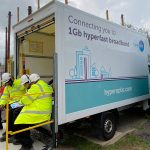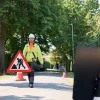BT Trial 5.6Tbps on a Single Optical Fibre and 2Tbps on a Live Core Link
Telecoms operator BT and Chinese technology firm Huawei have announced that they’ve successfully run two new fibre optic network trials, one that delivered 2Tbps (Terabits per second) over a 727km live core network link (London to Dublin) and another that pushed 5.6Tbps via a single optical fibre.
The developments mark a leap forward from the operator’s last closed network trial in October 2014 (here), which at the time claimed to have harnessed a “record spectral efficiency” of 5.97bit/s/Hz in order to deliver super channel speeds of 3Tbps (Terabits per second) over an existing 359km long fibre optic link using commercial grade hardware and software in a real world environment.
Advertisement
Crucially the latest 727km long 2Tbps trial sees BT successfully applying the same technology to their commercial fibre link, which is carrying live customer traffic between London and Dublin. Meanwhile the new 5.6Tbps trial is more akin to the original closed network test conducted in 2014, although it’s an example of what we could be seeing in the near future.
The clear advantage of upgrades like this is that they can be done without needing to lay new fibre optic cables, which is usually a heck of a lot cheaper.
Howard Watson, CEO of BT Technology and Service, said:
“BT scientists built the first commercial single mode optical fibre link back in 1984 and the BT Labs remain at the forefront of photonics research more than thirty years later.
The core network is the superhighway of the internet. It’s important that our core networks keep pace with the growth in bandwidth demands driven by take-up of high-speed fibre broadband, HD content, 4G smartphones and tablets and in the future, 5G services.
So we’re investing in our core, as well as in high-speed access technology such as fibre broadband, to make sure there is no capacity crunch and deliver the best possible speeds to customers.
These landmark trials show that we can easily turn up the dial to deliver the speeds needed in our core networks to stay well ahead of rising customer demand.”
Sadly BT doesn’t yet apply the same logic to domestic connections, where the copper cables in their hybrid fibre FTTC and G.fast broadband diet are still the main limitation and require a lot of upgrading in order for the services to keep pace with rising demands.
Deploying pure fibre optic cables to individual premises would be a lot more future proof and BT does intend to deliver over 2 million ultrafast Fibre-to-the-Premise (FTTP) lines within the next few years, although that’s only a small part of their overall network.
Advertisement
Unfortunately going further with FTTP would also take many years longer and require many billions more in investment, which is very difficult for the operator to justify to their shareholders.
Other Technical Trial Facts
- The 2Tbps trials exploit commercial flexible grid hardware and real-time flexible rate 64GBaud transponders. 64GBaud optical technology runs at twice the electrical speed of current deployed core optical network optical signals and is one of the key enablers for high-speed, long reach optical transmission.
- The live trials were conducted over a 727km commercial flexible grid optical core link between London and Dublin, based on Huawei’s OSN 9800/8800 and iManager U2000 platforms, carrying live 40/100G customer traffic. The link includes a 133km long unrepeatered submarine cable link from Dublin to Holyhead.
- The trials demonstrate, for the first time, the successful operation of real-time 64GBaud flexible-rate transponders allowing all-optical, long reach (unregenerated) superchannel transmission, with low latency.
- In addition, by exploiting flexible rate transponders, BT successfully demonstrated fast capacity turn up (or network upgrade) equivalent to ~2Tbps in one minute.
- BT and Huawei also successfully demonstrated a record real-time 5.6Tbps optical superchannel over a closed loop network running between the BT Tower and Adastral Park. This comprised 28 x 200Gb/s (64GBaud/QPSK) sub-channels, bundled together to provide combined capacity, achieving highest capacity and spectral efficiency.
Mark is a professional technology writer, IT consultant and computer engineer from Dorset (England), he also founded ISPreview in 1999 and enjoys analysing the latest telecoms and broadband developments. Find me on X (Twitter), Mastodon, Facebook, BlueSky, Threads.net and Linkedin.
« Hayton Council Criticises Wireless ISP for Broadband Overbuild Snafu

















































Comments are closed